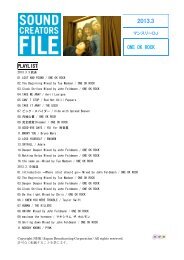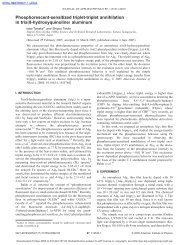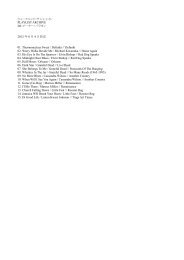Children's Television: Trends Around the World
Children's Television: Trends Around the World
Children's Television: Trends Around the World
Create successful ePaper yourself
Turn your PDF publications into a flip-book with our unique Google optimized e-Paper software.
CHILDREN’S TELEVISION: TRENDS AROUND THE WORLD<br />
119<br />
ing with <strong>the</strong> presenter to show how a gas mask is used. The format is intended<br />
to be gently informative, without leading to panic.<br />
Diversification of Programming for Preschool Children<br />
In Japan, programs aimed at <strong>the</strong> formative preschool years have been broadcast<br />
since <strong>the</strong> early days of television. The long-running Okasan to issho<br />
(With Mo<strong>the</strong>r), which continues to broadcast today, began in 1959. Three<br />
years prior to that, two programs intended for viewing at daycare centers and<br />
kindergartens were launched. There were a total of six such programs in 1960;<br />
each day, from Monday to Saturday, a different program was broadcast for<br />
this age group. The existence of two types of program for preschoolers—programs<br />
for viewing at home with family, and programs for viewing with<br />
friends at daycare or kindergarten—is a feature of Japanese children’s television.<br />
Commercial television stations, Nippon <strong>Television</strong> and Fuji <strong>Television</strong>,<br />
also began to show programs for preschoolers from <strong>the</strong> mid-1960s. 15<br />
The enormous potential of television for preschool education has been<br />
demonstrated all over <strong>the</strong> world by <strong>the</strong> program Sesame Street. In 1969, <strong>the</strong><br />
year of its launch on American public television, only a limited number of<br />
countries—including Japan, <strong>the</strong> United Kingdom, and Australia—offered regular,<br />
scheduled programs, with nationwide coverage, for preschoolers. In all<br />
of <strong>the</strong>se countries preschool television was started by public broadcasters, and<br />
educational programs for viewing at school were also launched early. It was<br />
during <strong>the</strong> 1970s that programs for preschoolers became widespread throughout<br />
<strong>the</strong> world. Then, in <strong>the</strong> 1990s, preschool television entered a new era of<br />
expansion in both <strong>the</strong> number and <strong>the</strong> diversity of <strong>the</strong> programs. During this<br />
period, which continues to <strong>the</strong> present day, <strong>the</strong> content and styles of preschool<br />
children’s programs have advanced considerably.<br />
Sesame Street: A Case Study of Topical Issues<br />
Sesame Street offers a case-study in successful, and highly topical, program<br />
design for this age group. Since its launch in 1969, <strong>the</strong> program’s development<br />
has been guided by annual assessments of <strong>the</strong> educational requirements<br />
of its viewers, and also by analyses of <strong>the</strong> viewers’ responses to <strong>the</strong> program.<br />
Localized versions of <strong>the</strong> program, adapted to suit <strong>the</strong> cultural and education-<br />
15 An article providing a chronology of key Japanese programs for preschoolers since 1953,<br />
along with an overview of <strong>the</strong> context in which <strong>the</strong> programs have been used is Kodaira<br />
Sachiko, “Henka suru yochien hoikusho ni okeru media no riyo ishiki: 2002-nendo Yoji<br />
Muke Hoso Riyo Jokyo Chosa kara” [Changes in Media Use and User Awareness at<br />
Kindergartens and Nursery Schools: From <strong>the</strong> 2002 Survey on <strong>the</strong> Utilization of NHK<br />
Broadcasts for Young Children]. HKC (June 2003), pp. 50–69.







